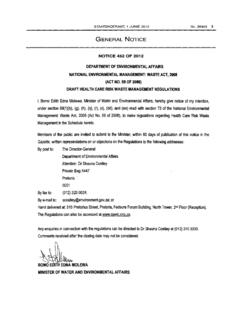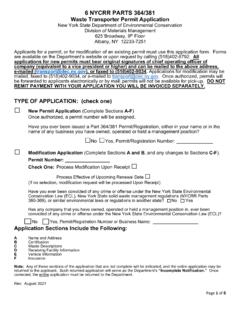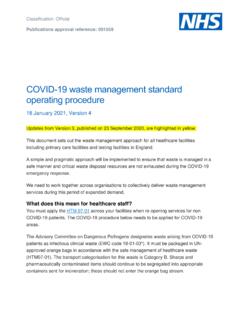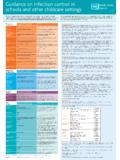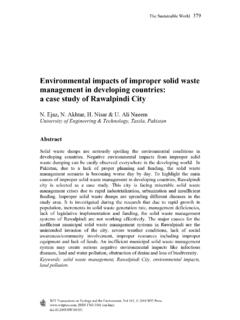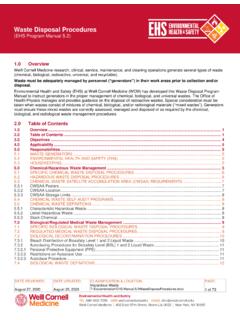Transcription of Composting Dog Waste - USDA
1 United States Department of Agriculture Natural Resources Conservation Service Fairbanks Soil and Water Conservation District December 2005 Composting Dog Waste For More Information usda Natural Resources Conservation Service 800 West Evergreen Avenue, Suite 100 Palmer, AK 99645 (907) 761-7760 Fairbanks Soil and Water Conservation District 590 University Avenue, Suite B Fairbanks, AK 99709-3641 (907) 479-1213 Credits Photos by Ann Rippy, Cassandra Stalzer and Mitch Michaud, Natural Resources Conservation Service. Compost bin illustrations by Ellen Million and No l Bell. Thanks to the Alaska Department of Environmental Conservation and the Environmental Protection Agency for support and funding of the original study. And a huge thank you to all the mushers and kennel owners who were willing guinea pigs and creative innovators.
2 The Department of Agriculture ( usda ) prohibits discrimination in all its programs and activities on the basis of race, color, national origin, sex, religion, age, disability, political beliefs, sexual orientation, or marital or family status. (Not all prohibited bases apply to all programs.) Persons with disabilities who require alternative means for communication of program information (Braille, large print, audiotape, etc.) should contact usda 's TARGET Center at (202) 720-2600 (voice and TDD). To file a complaint of discrimination, write usda , Director, Office of Civil Rights, Room 326-W Whitten Building, 1400 Independence Avenue, SW Washington, 20250-9410 or call (202) 720-5964 (voice and TDD). usda is an equal opportunity provider and employer. - 1 - Introduction Archeological evidence shows that dogs have been used in Alaska for hundreds of years as transportation, hunting, and pack animals.
3 The tradition of living close to canines continues today as Alaska dogs function as devoted pets, competitive athletes, and tireless laborers. The Environmental Protection Agency estimates that the typical dog excretes three quarters of a pound of Waste per day or 274 pounds per year1. A musher with a modest-sized kennel of 20 dogs must dispose of more than two tons of dog Waste annually! To get an idea of the scale of the dog Waste generated in Alaska, consider that in Fairbanks and Anchorage alone, an estimated 20 million pounds of dog Waste is produced each year. Left alone, dog Waste can pollute ground and surface water, attract flies and pests, cause an unpleasant odor, and create unsanitary living conditions for dogs. Dog Waste can also transmit parasites and infectious diseases. Composting dog Waste is a simple and inexpensive method for disposing of dog Waste that can enhance the environment and reduce the amount of Waste deposited in landfills2.
4 The Dog Waste Compost Study In 1991 the Fairbanks Soil and Water Conservation District, with technical assistance from the usda Natural Resources Conservation Service, conducted a study with dog kennel operators to evaluate the possibility of Composting dog Waste in northern climates. 1 The actual volume of dog Waste depends on the dog and its diet. Working dogs that are fed high protein, high energy diets of concentrated feed will produce less Waste than less active dogs that are fed a less concentrated feed. 2 This study only included dog Waste . Cat and other pet wastes were not studied. Cats may carry parasites that are harmful to human fetuses. We do not recommend adding cat Waste or cat litter to your compost. The goal of the study was to develop easy yet effective dog Waste Composting practices that reliably destroy pathogens found in some dog feces.
5 This publication draws upon the results of the original study and more than a decade of additional experience. The Benefits of Composting Composting removes raw dog Waste from the environment where it can pollute groundwater and streams. Good Composting destroys pathogens and produces a safe soil amendment. Good on-site Composting eliminates transporting dog Waste to a disposal facility. This saves time, money, energy, and landfill space. Good Composting produces a quality soil additive that improves both the physical condition and fertility of the soil. Uses for Dog Waste Compost Compost is an excellent source of organic matter to add to your garden or potted plants. It helps improve soil structure which contributes to good aeration and moisture-holding capacity. Compost is also a source of plant nutrients.
6 Compost can also be used as a mulch material. Dog Waste compost can be used as a soil additive for revegetation, lawn establishment, and planting beds. It should not be used on crops grown for human consumption. When used in a potting mix or flower beds, a 25 percent compost blend is recommended. Compost has a relatively high salinity and is not recommended for germinating seedlings. Dog Waste is a safe soil additive for revegetation and landscaping when it is composted properly. Composting can reduce the volume of dog Waste by 50 percent. The mature compost pile in the foreground once filled the bin seen in the background. - 2 - What is Composting ? Composting is the controlled breakdown or degradation of organic material into a product known as humus. Dog Waste Composting is a natural process that requires air, water, organic matter, microbes and a little human intervention.
7 Supplies Composting requires a supply of nitrogen-rich materials (sometimes referred to as green or wet materials) and carbon-rich materials (dry or brown materials). Nitrogen rich (wet) materials include: dog Waste green grass clippings vegetable Waste other animal manures bagged fertilizer Carbon rich (dry) materials include: sawdust chopped straw or hay shredded newspaper dog bedding fallen leaves A long-stemmed thermometer is necessary to monitor compost temperature and can be found at some garden supply stores. You might find a moisture meter helpful for monitoring the moisture content of the compost pile. You will also need a shovel or fork for turning the compost. Our experience was that a long-handled hay fork is easiest to use when turning and mixing, while a shovel is handy for adding and measuring ingredients.
8 You will need some kind of bin to contain the Composting material. You can compost in a pile or a pit, but it will be difficult to reach the high temperatures needed to destroy pathogens and the process will take longer. Bins improve aeration and facilitate easy turning of the compost. See bin designs on page 4. You will need at least two bins, one for collecting Waste while the other is actively Composting . You will also need a reliable supply of water. Although water from a garden hose is fine, you may want to temper your water by letting it sit in the sun to warm before adding it to the compost. Cold water, even from rain, will lower the temperature of the compost. This is one reason to keep a cover on your compost bin. REMEMBER Small particles have greater surface area than large particles. The finer your Composting ingredients are chopped, the hotter your compost will be and the faster it will progress.
9 The best carbon source identified in our study was fine sawdust like that found at a woodworking shop or construction site. & Dog bedding is a ready source of carbon rich material in some kennels. - 3 - Composting Dog Waste Step by Step There are two methods you can use to build your compost pile. The first is to collect the materials separately and then mix them all at once. The advantage of this method is that the materials will not begin to decompose until mixed. You will get the highest temperatures and the fastest compost when dog manure, carbon, water, and air are all introduced at the same time. However, this method might have a higher gag factor. The second method is to add the carbon source to the dog Waste as you collect it from the dog yard and mix it as it is placed in the bin. This method is easier and as long as the pile remains dry, very little decomposition should happen until you are ready to turn the pile and add water.
10 Because the pile of mixed dog Waste and carbon will have a less offensive odor than if the materials are collected separately, many people prefer this method. To begin, choose a sunny, dry site near the dog area for your compost bin. The site should not be near pregnant or nursing dogs, or where runoff from the pile would flow into the dog yard. For every two shovels full of dog Waste , add one shovel full of sawdust or other carbon source. Mix thoroughly after each addition. Add water in small amounts until the compost mixture is as moist as a wrung out sponge. Continue adding ingredients until the compost is two to three feet deep. Once a bin is full, do not continue adding fresh materials. Place a cover on the compost mixture. Microbes will begin breaking down the organic materials. As the microbes go to work, they release heat and increase the temperature of the compost pile.










